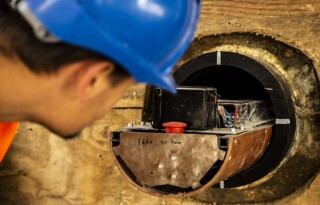HyperTunnel has constructed what is claimed to be the world’s first underground structure built entirely by robots.
Hypertunnel was started up in Basingstoke in 2018 by two men with no experience of engineering or construction but with an idea to build tunnels using a combination of horizontal directional drilling, artificial intelligence and 3D printing.
HyperTunnel reckons that its automated construction method will be able to build tunnels more than 10 times faster and at half the cost of conventional methods. And without any human needing to enter the structure during construction, its method could transform safety in the tunnelling industry too.
Using swarm construction methods according to a digital twin of the tunnel, a fleet of ‘hyperbot’ robots enters the ground via an arch of high-density polyethylene (HDPE) pipes. Once inside, the robots 3D-print the tunnel shell by deploying construction material directly into the ground.
The Peak XV pilot project is a ‘pedestrian-scale’ tunnel measuring just six metres long, two metres high and two metres wide. It was constructed as part of a project for Network Rail and revealed at the British Tunnelling Society Conference & Exhibition in London this month.

Network Rail is interested in the possibility of the method being used to repair old tunnels.

Network Rail engineer David Castlo – network technical head (mining and tunnels) – said: “Our large portfolio of Victorian tunnels requires increasing levels of work to meet the needs of the railway network. However, we want to reduce the level of disruption to our passengers so we are constantly searching for new approaches to enlarging or repairing tunnels that reduce the length of time a tunnel will be closed to trains. Peak XV moves us a step closer to that goal and, crucially, with a method that reduces workforce safety risk.”
Steve Jordan, co-chief executive and co-founder of HyperTunnel, said: “To unveil our first large scale demonstration tunnel is a big step, not only for HyperTunnel, but for the tunnelling and construction industries, which are eagerly anticipating the readiness of our approach to use, as appropriate, in their global projects. While using robots exclusively to build underground structures is dramatically different, the contributing technologies, such as digital twins, robotics, 3D printing and digital underground surveying, supported by AI and VR, are all well-proven in other industries. In fact, the HyperTunnel in-situ method is all about de-risking construction projects.”
Earlier this year, HyperTunnel received funding of €1.88m from the European Innovation Council (EIC) Accelerator scheme. The company also received a financial investment from French construction group Vinci.
Got a story? Email news@theconstructionindex.co.uk


